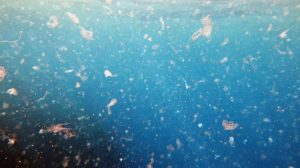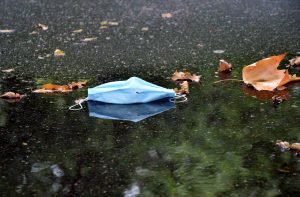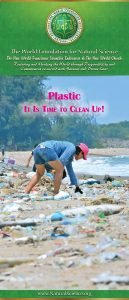No water, no life. Earth is a water planet, as about two thirds of its surface consists of water. The same is true for our bodies, and if we do not regularly fill up our “body reservoir” with pure water, after a week at the latest we are no longer alive. It is obvious, therefore, that we must treat precious water with the greatest respect and protect it and conserve its purity.

Sadly, we are currently quite far away from that. The waters of the world are massively contaminated by (industrial) wastes, pesticides and fertilisers, electrosmog (lately even under water), drug residues or even plastic. Microplastics (plastic that is smaller than 5 millimetres) in particular are becoming increasingly a problem. Microplastics result, for example, from the abrasion of car tyres, from synthetic fibres of clothes that get into the environment directly or during washing, from discarded cigarette butts, from tiny plastic particles for example in cosmetic products, toothpaste or shower scrubs, but also when plastic breaks down in the environment. In the end, the microplastic particles usually land in the oceans, where there are already more than 5 trillion of the tiniest particles swimming on the water surface.
Every person on the planet produces around one kilogram of microplastic per year. That leads to microplastics occurring practically everywhere today, be it in drinking water, in the soil or even in our food. Already in 2009, plastic residues could be detected in the blood of 95 out of 100 Austrians.1)https://www.researchgate.net/publication/236595527_Schadstoffe_im_Menschen_-_Ergebnisse_einer_Human-Biomonitoring-Studie_in_Osterreich In 2018, scientists from the University of Vienna also found microplastics in human stool for the first time, which proves that microplastics also enter our bodies through food.2)https://www.researchgate.net/publication/328702413_ASSESSMENT_OF_MICROPLASTIC_CONCENTRATIONS_IN_HUMAN_STOOL_-_FINAL_RESULTS_OF_A_PROSPECTIVE_STUDY People in fact consume an average of around 5 grams of plastic per week, which amounts to about 2,000 microplastic particles or, to put it somewhat more graphically, a credit card.3)https://www.newcastle.edu.au/newsroom/featured/plastic-ingestion-by-people-could-be-equating-to-a-credit-card-a-week
If you think you could reduce your microplastic “consumption” by drinking bottled water, then you are wrong. In fact, by drinking only water from plastic bottles, you actually take an additional 90,000 microplastic particles into your body each year – in other words, about 45 credit cards more. Studies show that bottled drinking water contains about double the amount of microplastics as tap water. However, the differences between individual products are huge. Of all the tested mineral waters, Nestlé Pure Life contained 10,390 microplastic particles per litre. The least polluted product, San Pellegrino, had 74 particles per litre.4)https://childrenshealthdefense.org/defender/bottled-water-twice-micro-plastic-tap/ and https://orbmedia.org/plus-plastic
 As a result of Covid waste, the plastic problem has taken on completely new dimensions and practically nullified the efforts of the last few years to curb plastic consumption. As stated in a WHO report published on 1 February 20225)https://www.who.int/publications/i/item/9789240039612 , the amount of waste has increased massively as a result of the Corona measures. Rapid tests, protective clothing, disposable gloves, disinfectants, all of these produce hundreds of thousands of additional quantities of waste which is rarely disposed of properly. This applies particularly to face masks which are usually made of one or more layers of plastic, usually of very long-lasting polypropylene. Around 129 billion masks are used worldwide every month – around three million masks every minute! This means that the production of disposable masks has now reached similar proportions to that of plastic bottles and bags. Scientists of the University of Southern Denmark and Princeton University warned that face masks are often not disposed of properly (often they are just carelessly thrown away somewhere in the environment where they decompose into microplastics) and could thus become a global environmental problem.6)https://www.engineering.org.cn/en/10.1007/s11783-021-1413-7
As a result of Covid waste, the plastic problem has taken on completely new dimensions and practically nullified the efforts of the last few years to curb plastic consumption. As stated in a WHO report published on 1 February 20225)https://www.who.int/publications/i/item/9789240039612 , the amount of waste has increased massively as a result of the Corona measures. Rapid tests, protective clothing, disposable gloves, disinfectants, all of these produce hundreds of thousands of additional quantities of waste which is rarely disposed of properly. This applies particularly to face masks which are usually made of one or more layers of plastic, usually of very long-lasting polypropylene. Around 129 billion masks are used worldwide every month – around three million masks every minute! This means that the production of disposable masks has now reached similar proportions to that of plastic bottles and bags. Scientists of the University of Southern Denmark and Princeton University warned that face masks are often not disposed of properly (often they are just carelessly thrown away somewhere in the environment where they decompose into microplastics) and could thus become a global environmental problem.6)https://www.engineering.org.cn/en/10.1007/s11783-021-1413-7
The effects of microplastics in the human body are diverse and are by no means to be taken lightly. For example, microplastics have been linked to obesity, diabetes, heart disease, cancer, reproductive problems and attention deficit disorders.7)https://royalsocietypublishing.org/doi/10.1098/rstb.2009.0053 Other studies prove that inhaled microplastics can affect the lungs8)https://www.ncbi.nlm.nih.gov/pmc/articles/PMC7424328/ as well as penetrate the blood-brain barrier and damage brain cells.9)https://www.ncbi.nlm.nih.gov/pmc/articles/PMC7282048/ Likewise, a new study from Hull York Medical School from December 2021 concludes that we are ingesting microplastics in toxic quantities and that the body reacts to them among other things with allergies and cell death.10)https://www.york.ac.uk/news-and-events/news/2021/research/microplastics-harmful-human-cells/
Therefore, the resolution adopted by the UN Environment Assembly in early March 2022 to negotiate a comprehensive global plastics agreement is a step in the right direction. The negotiations, which will begin in the second half of the year, are intended to result in a binding decision by the end of 2024 that will regulate the plastic problem as it were from the cradle to the grave by reducing global plastic production, developing ways to extend the lifespan of plastic goods and finding better recycling and disposal solutions.
 It is likely to take quite a while, however, before truly effective measures are implemented. In the meantime, each and every one of us can do something to mitigate the plastic problem by limiting their own plastic consumption. For concrete tips, see our brochure “Plastic—It is Time to Clean Up!”
It is likely to take quite a while, however, before truly effective measures are implemented. In the meantime, each and every one of us can do something to mitigate the plastic problem by limiting their own plastic consumption. For concrete tips, see our brochure “Plastic—It is Time to Clean Up!”
References








